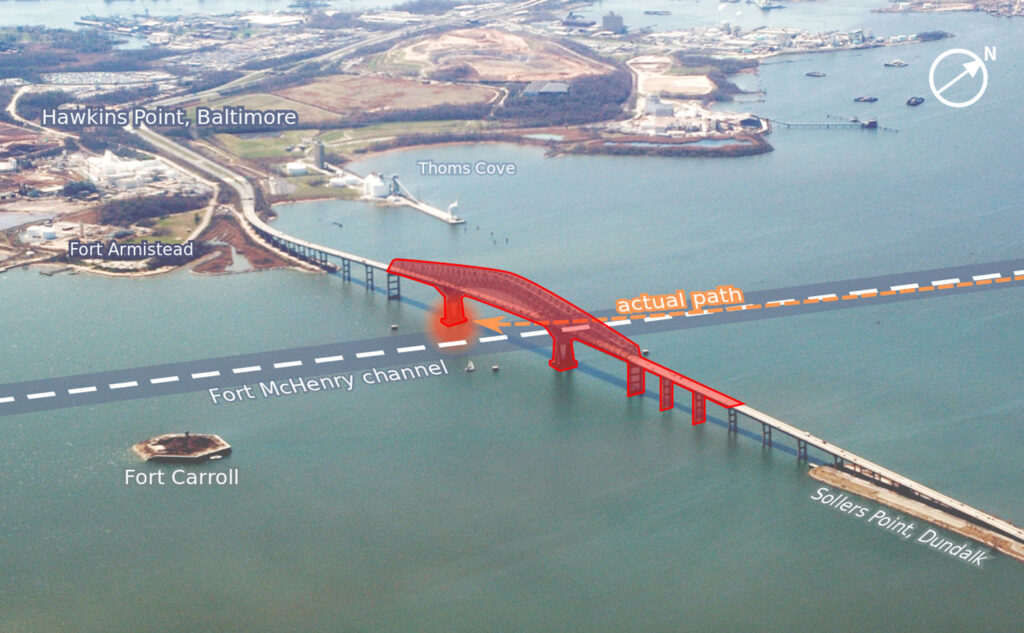With 80% of global cargo moved by ships, the Maritime Shipping series with Don Maier, associate professor of practice in supply chain logistics, provides clarity to the challenge of how goods are moved on the high seas. Read his first post about the consequences of geopolitical issues affecting trade through the Suez Canal.

The recent bridge collapse in the Port of Baltimore is a tragic reminder of life’s fragility. The entire supply chain industry mourns for the construction workers who perished when the M/V Dali allided with the Francis Scott Key Bridge on March 27. (“Allision” is the term the US Coast Guard uses when any type of vessel contacts a stationary object or structure).
As officials and salvage crews work to clear the debris and reopen the ship channel, most of the cargo destined to and leaving from the Port of Baltimore must be diverted, if it moves at all. Over recent years, supply chains have become more flexible, thereby creating resiliency. But doing so takes much more effort in planning, risk management, developing scenario testing, communication, and patience.
As of this writing, many shipping lines have announced diversion plans, with much of the volume going either to the ports of New York/New Jersey or Norfolk. Bethann Rooney, port director of the Port Authority of New York & New Jersey, said that “all 10 of the container services which call the Port of Baltimore also call the PONYNJ, so it is relatively easy to remove the containers originally destined to Baltimore in the PONYNJ,” since the vessels were already scheduled to call at each port.
Maersk, MSC, and other lines published updated departure and arrival dates. The difference in whether they’ll arrive later or, in some cases, earlier at each port depends on whether the vessel was calling on Baltimore before or after PONYNJ. A similar situation exists with Port Norfolk. In most cases, the diversion adds or subtracts no more than two days, depending on the voyage plan of the vessel.
Like any manufacturing or service operation, success is a matter of efficiency. Ports operate under the same precepts of efficiency, whether the number of lifts moved per hour, total vessel call time, or other metrics. The situation in Baltimore should remind us that our supply chains must focus on a total system view, not just when the cargo arrives or departs in a particular port. The pandemic highlighted that point exponentially, and the Keys Bridge is another example of the importance of managing from a total systems view.
A port can discharge and reload a vessel only as efficiently as the terminal can move cargo in and out. Like any warehouse, it can only receive or load so many trucks based on factors, including space, equipment, and labor. For example, if a port offloads 2,000 FEUs—40-foot equivalent units—from one ship (the M/V Dali has a capacity of over 4,000 FEUs), it must ensure enough terminal space to accommodate those containers. Theoretically, the PONYNJ and Norfolk must have space to accommodate the additional volume on top of their already scheduled, normal volume.
Fortunately, time and space (or size) are on the side of the ports. Rooney explained, “The PONYNJ is currently handling about 20% less than we did at the height of the pandemic, so we have more than enough capacity to efficiently handle any Baltimore diverted here.” Rooney told me what Baltimore handles in a year, the PONYNJ typically handles in two or fewer months. Rather than receiving additional vessels, they’re simply taking more cargo off ships already en route.
A second system view factor to consider is equipment. After containers are discharged from a vessel, a truck moves the freight from the terminal to the destination for distribution or transloading. Planning ahead remains critical. That is why, within hours, Rooney and her team began preparing for the diversion of volume. Within a day, they “were already issuing credentials to Baltimore truckers planning to pick containers up here [PONYNJ] and have been working with Class 1 railroads to transfer containers bound for the local Baltimore region back to the Port of Baltimore which will help keep the local workforce engaged”. Essentially, some diverted volume will move from PONJNY to the Baltimore area either through a Class I railroad or by truck.
Labor is a third and critical system factor in terms of availability and ability to perform the necessary work. Whereas equipment can be moved from one region to another, labor cannot. Since some container volume has lessened in PONYNJ, Rooney explained that the “existing ILA [International Longshoremen Association] workforce in PONYNJ has not been getting hours lately,” leaving excess capacity to put the longshoremen back to work. Norfolk appears to have taken a different approach, planning to bring Baltimore ILA down to help with diverted autos, as Norfolk manages much less Ro-Ro volume than Baltimore. Given that situation, the ILA may not have as much experience with Ro-Ro cargo, emphasizing why anticipating, communication, and risk management scenario planning is critical.
While container volume is usually the focus of terminal operations, bulk and project cargo is just as critical. It requires the same factors described above, with more emphasis on space and equipment. The Port of Baltimore handled nearly 23 million metric tons of coal in 2023, making the port second in coal shipments (followed by the Port of Norfolk). With the second largest coal port out of commission for the moment, coal buyers and sellers need to evaluate their next move; specialized space and equipment to store and move coal may not be available in Norfolk.
Communication to coordinate allocating the railcars may be possible, yet moving the specialized conveyance systems may not be. Sugar is another commodity that relies heavily on the Port of Baltimore, with a Domino refinery in the upper channel producing nearly 6 million pounds of refined sugar daily. Fortunately, the refinery recently received two vessels, providing enough inventory for the time being.
Currently, most cargo is in the process of being diverted to nearby ports. That cargo will then be transported back to the Baltimore area. The process will help keep a supply chain more intact (closer to “normal” operations). Plus, doing so will help the local economy recover sooner, with employees returning to work. One factor that should soon receive more attention is the additional congestion in the Baltimore area from an increase in trains and trucks moving freight from either PONYNJ or Norfolk. Truck traffic will need to be diverted around the city, and no hazardous material will be allowed through the tunnel. That will increase freight traffic on the local interstate system.
Diversions will augment operating costs, which the buyer or seller will absorb. What remains to be seen is whether companies will pass the additional cost on to consumers. The longer the navigation channel remains closed, the more costly it will become for everyone. When will the US Corp of Engineers and the US Coast Guard open the port to regular ship traffic? It’s anyone’s guess. Only time will tell. For supply chain professionals, and all of us as consumers, patience will be the next critical factor in helping overcome this challenge to our global supply chain.
